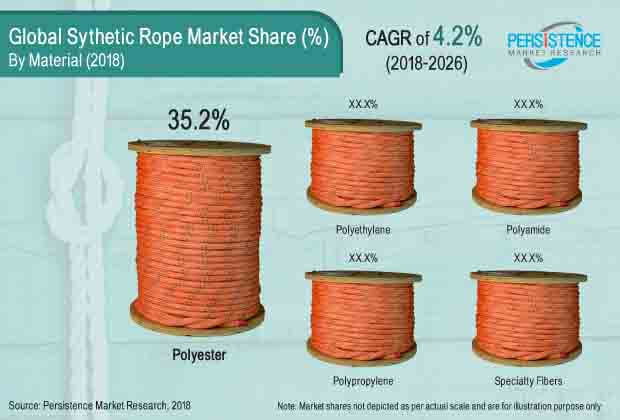Synthetic Rope Market Segmented By Polyethylene, Polypropylene, Polyester, Specialty fiber, Polyamide in Marine and fishing, Oil and gas, Construction, Cranes
Industry: Chemicals and Materials
Published Date: August-2018
Format: PPT*, PDF, EXCEL
Delivery Timelines: Contact Sales
Number of Pages: 177
Report ID: PMRREP18328
A synthetic rope is a bundle of flexible synthetic fibers that are braided or twisted together to enhance its length and tensile strength. Synthetic ropes are made of synthetic fibers, such as nylon, polyester, polyethylene and polypropylene, among others. Generally, synthetic ropes are manufactured using different types of fibers, such as multifilament, staple fibers or fiber films.
Various beneficial properties offered by synthetic ropes are their high strength, durability, light weight and corrosion resistance. Due to these distinguishing characteristics of synthetic ropes, they are mostly preferred over steel ropes. Synthetic ropes find numerous applications in various end-use industries, such as marine and fishing, oil and gas, construction, among others.
The global Synthetic Rope market is estimated to be pegged at around US$ 1,548.7 million in 2018 and is expected to register a CAGR of 4.2% over the forecast period (2018–2026).
The global population is expected to reach 9 Bn by the end of 2050. With this significant growth in world’s population, concerns pertaining to food security and nutrition are becoming a vital issue in developing and developed regions. For the same, fisheries and aquaculture sectors are channelizing efforts to cater to the growing demand for food and related non-food products.
According to the Food and Agriculture Organization of the United Nations, the global fish production was around 171 Mn tons in 2016. Of this, around 88% share was used for direct or indirect human consumption, wherein 47% was accounted by aquaculture production and 53% came from capture production.
With this significant rise in consumption and demand for fish products, the fishing industry is expected to grow steadily over the forecast period. Synthetic fibers are an indispensable part of the fishing industry and are prominently used in fishing nets, twines and ropes.
Synthetic ropes are used in trawling applications as they offer several benefits, such as better abrasion resistance, high breaking strength, high strength to weight ratio and better grip and light weight, among others. Owing to these factors, the demand for synthetic ropes is expected to increase at a fast pace during the forecast period.
Moreover, the maritime transport sector has registered moderate growth since the economic downturn of 2008-09. The global shipping industry constituted over 85% of world trade, which includes trade of oil & gas, main bulks and dry cargo. According to UNCTAD, the global seaborne trade increased by 2.6% in 2016, in terms of volume, and is expected to grow at a CAGR of 3.2% over the period 2017-2022.
With the growth in seaborne trade and increasing size of cargo, the demand for high performance, lightweight, cost-effective and safer ropes is increasing for mooring lines, tow line and lifting operations. Thus, the significant growth of the shipping industry and seaborne trade will in turn help to drive the demand for synthetic ropes over the forecast period.

From a regional perspective, the Synthetic Rope market in North America is projected to witness relatively significant growth and is likely to maintain its dominance in the global Synthetic Rope market over the forecast period. Moreover, the China Synthetic Rope market is projected to represent significant incremental opportunity between 2018 and 2026. This is mainly attributed to significant growth of end use industries, such as shipping and fishing industry, in the country. South East Asia and Pacific Synthetic Rope market, on the other hand, is estimated to expand at a healthy CAGR, in terms of value and volume, over the forecast period.
Some of the players reported in this study on the global Synthetic Rope market are WireCo WorldGroup Inc., English Braids Limited, Samson Rope Technologies Inc., Teufelberger Holding AG, Lanex AS, Axiom Cordages Limited., Touwfabriek Langman BV, Yale Cordage Inc., Bexco NV-SA., Atlantic Braids Ltd., Unirope Ltd., Dong Yang Rope Mfg. Co., Ltd., Cortland Limited and others.
Synthetic ropes manufacturers have been channelizing efforts towards strengthening their production capacity volumes and are focusing on specific regions to cater to regional markets. This is expected to positively impact the synthetic rope market in near future.
| Attribute | Details |
|---|---|
| Material Type |
|
| Application |
|
| Region |
|
To know more about delivery timeline for this report Contact Sales
